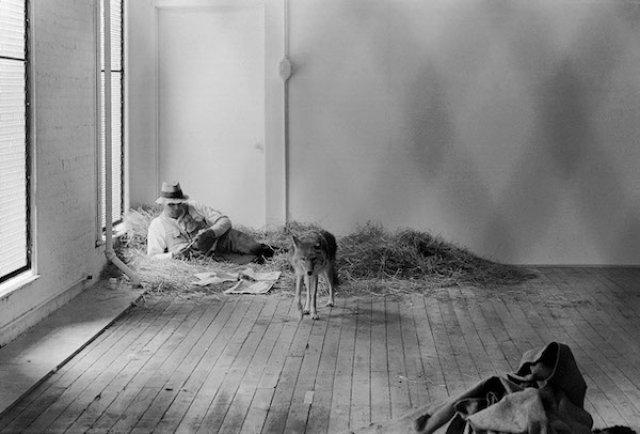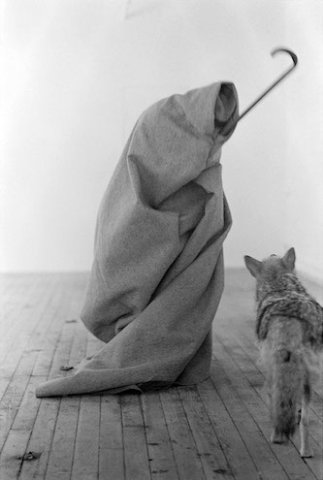Joseph Beuys and the Cayote
Iconic Installation That Too Few Saw
By: Charles Giuliano - Jun 09, 2024
It is ironic — but understandable — that 50 years ago only a handful of people experienced what has become one of the iconic happenings of 20th century art.
An Artist, A Coyote, and a Cage: Joseph Beuys in New York, 1974 Photographs and an essay by Stephen Aiken. Foreword by Brett Sokol. Letter 16 Press, 84 pages, $45.
Few if any are aware that, 50 years ago, for three days in Manhattan, the German artist Joseph Beuys (1921-1986) created one of the art world’s legendary “actions” (performance art pieces).
The artist had himself wrapped in felt and blindfolded when he was conveyed to a gallery and then back to the airport. The semi-mummified Beuys was delivered by ambulance to the Rene Block Gallery in SoHo, where he created the controversial work I Like America and America Likes Me. The set-up: a man and a wild coyote were locked together inside a room.
One of the impulses behind Beuys’ choice of transport: the activist artist would not set foot on American soil. A veteran of the Luftwaffe, Beuys would later co-found Germany’s Green Party.
It was Memorial Day weekend, a time when New Yorkers, and in particular the art world, officially deemed the season ended and decamped to the Hamptons. (I have been in New York during that holiday and found most of the galleries closed.)
In terms of promoting the project, the artist and gallery could not have chosen a less propitious time. It is ironic — but understandable — that only a handful of people experienced what has become one of the iconic happenings of 20th century art.
Work by Beuys was first shown in America at Boston’s Barbara Krakow in 1972. The latter is known for a sharp eye that specialized in works on paper.
Beuys refused to travel to America during the Vietnam War, until he finally accepted the invitation of New York gallerist Ronald Feldman. (The Vietnam War ended in April, 1975. Four years later, Beuys was the subject of a Solomon R. Guggenheim Museum exhibition.)
For his first trip to the US, Beuys chose not to do an exhibition, but to engage in public dialogues with students and women’s groups in New York, Minneapolis, and Chicago. The tour started at the New School for Social Research in New York on 11 January, with a three-hour conference entitled The Energy Plan for the Western Man. When Beuys visited NYC he avoided the art world. Despite that, there were people banging on the door to be admitted to his lecture and panel discussion at the New School.
In May of that year, Stephen Aiken, then a young artist from Boston, wandered into the Rene Block Gallery. He asked an apathetic attendant if he might be allowed to photograph the performance. Aiken ran home; he returned with a camera and a single roll of film. In text and images, this new book documents what he experienced.
There were so few witnesses a myth has grown up around the performance. Where did Beuys sleep and eat? What about bodily functions? It appears that the artist was aware of — and responded to — the rare visitor, including noting a camera.
Beuys initially planned a five-day event. But the gallery proved to be too pristine, with polished floors and crisp walls. He was looking for a more elemental setting. And there was also a desire for safety: the need to erect a fence around the wild coyote and protect the occasional visitor.
For eight hours over three days the artist shared the cage with the animal. There was straw bedding as well as stacks of newspapers, which the animal soiled. These become artifacts that were signed and later sold.
Aiken’s images document that, at times, the artist was shrouded in felt as he conversed with his canine roommate. They appear to have reached a détente, sharing what might best be described as an apathetic coexistence. The coyote mostly slept — there does not appear to have been any acts of aggression. Why was Beuys wrapped in felt? The choice of material is rooted in the artist’s past. During WWII, Beuys’ plane was shot down in the Crimea. He survived the crash and was found by Tartars after several days struggling to survive alone. To combat the onset of hypothermia, they smeared Beuys with fat and wrapped him in felt. Later he was taken to a German field hospital by sled. This rescue — and its cathartic Saul-to-Paul resonances — became major signifiers in Beuys’ art work.
I Like America and America Likes Me is a powerful metaphor, but for what? The resonances of the performance are complex and ambiguous. The short answer is that Beuys was assuming the role of shaman and that the “wild” coyote stood for untamed America. The coyote has long been a powerful — even archetypal — element in Native American culture. Every effort has been made to eliminate the animal, and yet they endure, even in urban environments.
When Beuys died, the content of his studio was trashed. Few of his installations remain in their original form. Then — and now — the art world doesn’t know what to make of his work, particularly in this highly theatrical vein. We should be grateful for An Artist, A Coyote, and a Cage, which documents an important moment of aesthetic/political dissent. How fortunate we are that Aiken went home and got his camera.


